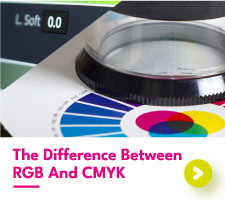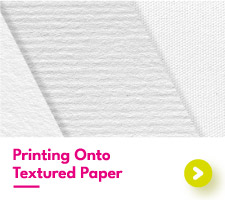How AI Is Shaking Up The Print Industry
How AI Is Shaking Up The Print Industry
Since the boom of AI in 2022, the print industry has experienced revolutionary changes. AI has quickly become embedded in the printing process; its effects being felt across the entire print chain – from pre-production to print management to customer service and beyond. We’ve decided to take a deep dive and discover the ways in which AI has been implemented in different areas of the print industry, along with looking at the benefits the AI technology has to offer.
Table of contents:
What is AI in the print industry?
AI In Print: Before The Printing Begins
AI In Print: During The Printing Stage
AI In Print: After The Print Stage
AI In Other Print-Supportive Roles
AI, Print Suppliers, And Stock Management
What Is AI In The Print Industry?
Artificial intelligence AI is software that learns from and mimics human behavior in order to successfully perform tasks. This can be anything from replicating human speech patterns for customer service chatbots to analyzing spreadsheets to find data patterns and much more. AI in the print industry can come in many forms, some of which we are about to explore in-depth below.
AI in print is primarily used for saving both time and money. But, AI based activities have many other benefits, including environmentally friendly printing, increasing customer satisfaction, and the creation of a tailored print experience.
AI In The Print Industry: Looking At The Complete Printing Cycle
AI In Print: Before The Printing Begins
Before the print process begins, before the print machines are set up and customer artwork is prepped, an order needs to be placed. We all know that the user experience of a print website will heavily affect whether someone chooses your company over a competitor site. Slow sites that don’t respond to user needs will be quickly left in favor of a faster, more tailored experience.
AI can be used to create a personalized web experience for customers. Say a customer is looking at bookmarks on your site, responsive AI would recommend other types of bookmarks (such as metallic foiling or die cutting) that a customer is likely to be interested in. Relevant recommendations are more likely to steer customers in the right direction, helping them to find the product they need and helping you to secure a sale.
Another dramatic effect that AI has had on the print industry is with the pre-press workflow. AI has allowed for the introduction of automatic file preparation, which shows customers a digital proof of their print-ready artwork from files uploaded to the print site, almost immediately. The automatic files provided are set up for print, with correct bleed and safety margins, and are checked thoroughly to ensure the image quality will be crisp.
Automatic file preparation doesn’t just save a ton of time, it can also help to prevent costly printing mistakes. As AI is trained to scan hundreds of files, it can quickly detect any potential faults before the artwork is even printed. The customers receive real-time advice on how best to alter their files to ensure that the print results are high-quality.
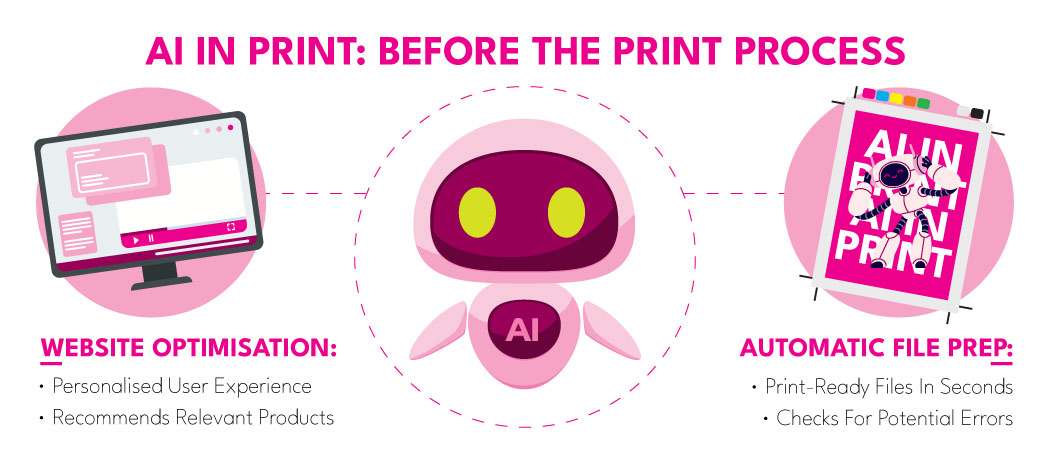
AI In Print: During The Print Stage
AI printing software is a favorite installation on print machinery as it helps to maximize space on a single sheet of paper. In the day-to-day running of a print studio, you’ll receive orders in all sizes and quantities. Fitting all these different print specs onto one sheet of paper is a task that may puzzle even the most experienced print staff. In this game of Tetris, paper space is often wasted or could be better used. This is where AI printing software comes in. AI can take the print sizes and border measurements of many orders and calculate how to create the most efficient print layout, saving paper, energy, and of course, money.
Colour management is another popular use of AI powered software. Getting colors to be consistent across different print machines, paper types, and special finishes is a constant battle. It’s likely that a bold pink on one paper will appear more muted on another – which isn’t what we want! AI color management monitors printers and can quickly detect when a color makeup may have deviated from the original color profile. Instead of having to manually calibrate the machine back to the right color, AI can make this change automatically. Printing consistent colors reduces costs with reprints and saves print staff time that would be better spent elsewhere.
Alongside the specific AI software inside the printer, AI can also be used to manage the workflow of the shop floor. In a process known as predictive maintenance, AI oversees the production cycle, knowing where materials are used and where bottlenecks have occurred. AI can also monitor the number of orders a studio needs to produce and set deadlines to keep on track. Print staff can therefore spend less time arranging their day, as AI will organize it for them.
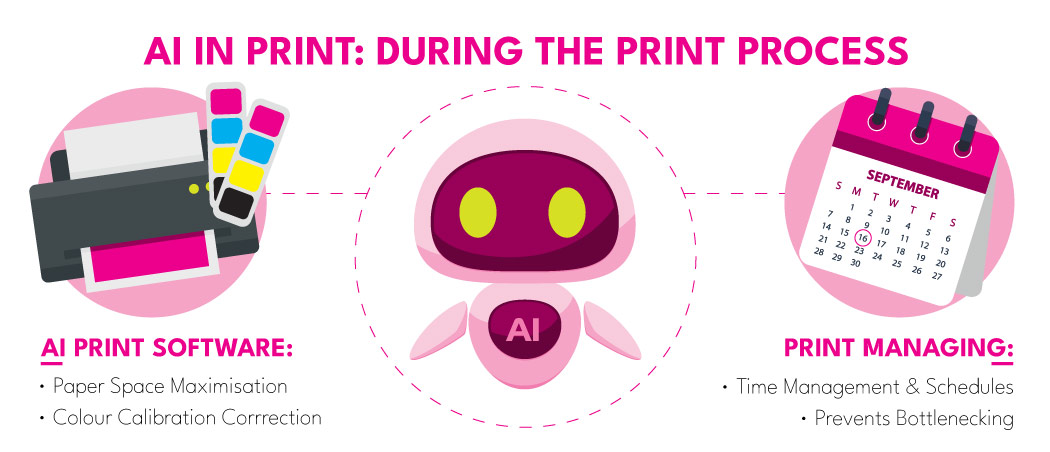
AI In Print: After The Print Stage
As print orders are completed, the quality of the print must be checked before being sent out to a customer. The customer experience with your company is crucial, and misprinted artwork will destroy any chance of building a long-standing relationship. Quality control AI uses cameras trained to identify potential faults. Whether this is through misalignment of the crop marks or physical damage to the surface of the paper, AI sifts through to prevent these prints from ever reaching the customer.
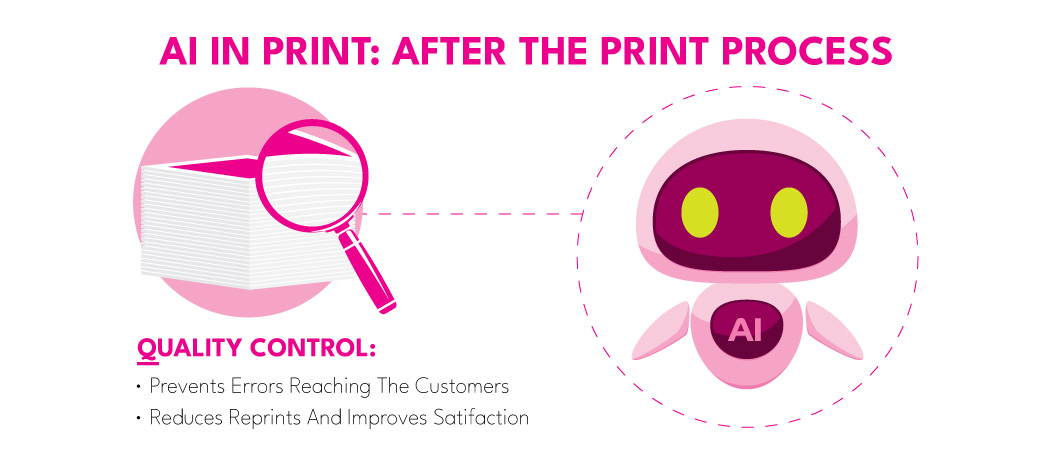
AI Within Other Print-Supportive Roles
AI driven procedures haven’t just been implemented into the print production process. Supporting roles have also heavily been impacted by the rise of artificial intelligence.
Customer service, for example, has been taken over by AI chatbots in recent years. AI chatbots can communicate directly with customers, sending them to the correct pages on your website and providing helpful resources with ease. Answering surface-level queries frees up time for your human staff to take care of more complex inquiries and man the phone lines with the best customer experience in mind.
Marketing is another area that has been impacted by the rise of AI. With the help of AI, marketers can produce top-quality content that is designed around a customer’s wants and needs. Personalized content, such as email marketing, based on past orders and search queries is more likely to be positively responded to. This in turn drives up sales and increases overall customer satisfaction.
Design-based AI programs have allowed those with less creative experience to produce their own artwork online. Print companies can use the same programs to help their customers with bespoke designs and print layout help. As many print businesses don’t already provide a design service, AI design programs open the door for in-house designing to be offered to those in need.
AI, Print Suppliers, And Stock Management
Spreadsheet analyzing and inventory management traditionally would take up large chunks of time, but with AI this is no longer the case. AI systems can stock take and alert print suppliers when certain paper types, inks, and laminates might be low and need to be replaced. Keeping on top of the stock-taking prevents printers from running out of much-needed materials and then having to wait for new shipments to arrive.
Not only can AI monitor current stock levels, but it can also predict the future requirements that a print company may need. By scanning customer orders, AI can identify patterns and trends to accurately predict when more paper and toner will need to be ordered. Along with preventing print companies from coming up short, AI pattern prediction can also prevent businesses from ordering potentially unpopular products. Over-ordering leads to precious print shop workspace being taken up with unmoving stock, which will then inevitably lead to waste as it is thrown out to clear away some space.

AI And Sustainability
The introduction of AI has performed wonders in the print sector, saving time and money everywhere it goes. But what about sustainability?
AI based strategies, including paper space maximization and automatic color calibration, have greatly reduced the amount of paper waste produced per order. This is partly due to getting the absolute most out of one sheet of paper. But this is also due to the drop in reprints needed for unhappy customers. Print can sometimes go wrong – it’ll always happen – but AI helps to minimize these faults and so reduces order reprints.
Correct stock management helps companies to use the materials that they have to hand before purchasing more. AI management ensures printers know exactly what they have in-house, what needs to be ordered, and what should not be ordered again. Knowing exactly what should be ordered prevents the ordering of unwanted products that would otherwise be thrown away to free up space.
Printing With AI Is Here To Stay
There is no doubt that AI in the print industry is here to stay. With artificial intelligence streamlining the workflow, increasing productivity and customer satisfaction, the future is likely to see more print businesses adopting the software. AI should be treated as any other assistive program, something that is designed to help, not hinder. Of course, human print staff will always be behind the scenes, constantly improving and driving businesses forward. Together, AI and human printers are revolutionizing the print industry, stepping forward into a new era of printing as we know it.

 UK
UK FR
FR















